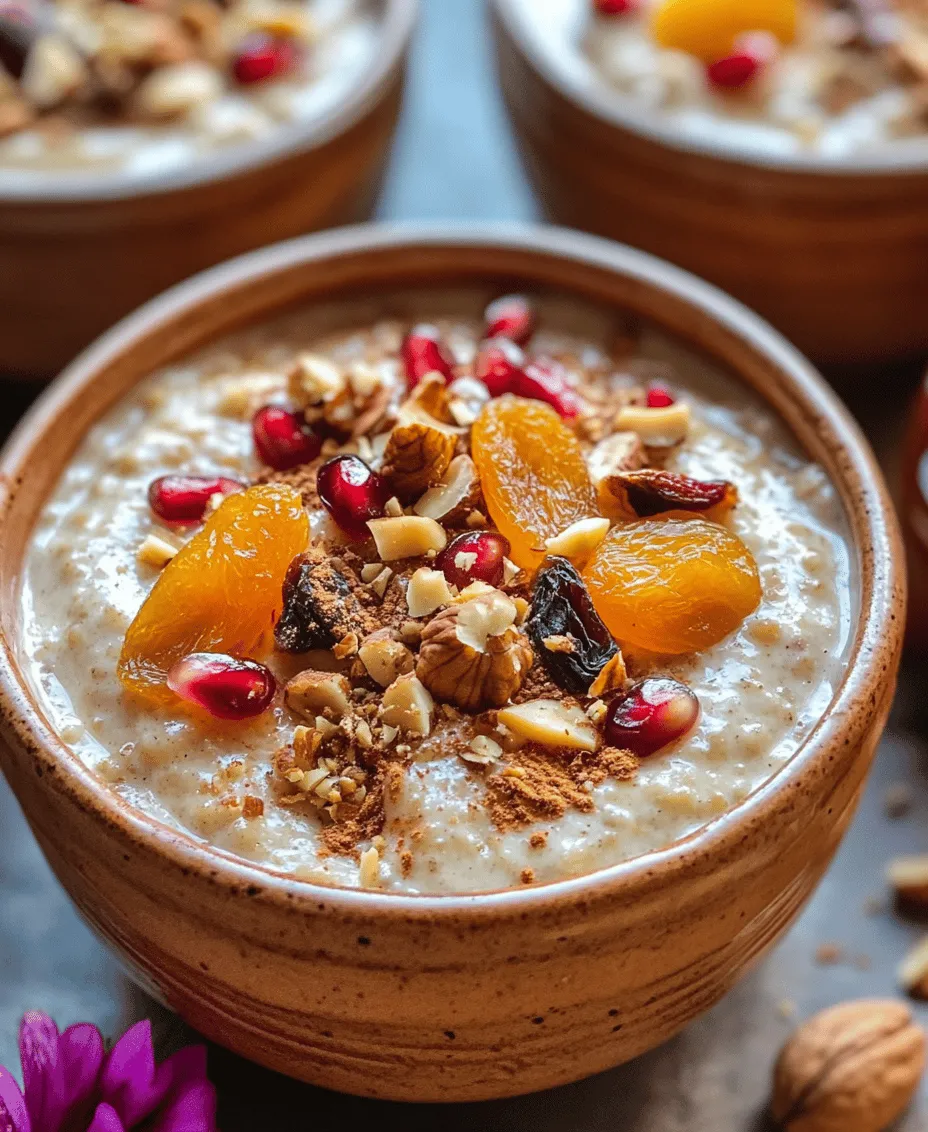Ashure, also known as Noah’s Pudding, is more than just a dessert; it is a cherished symbol of cultural heritage, unity, and abundance. This traditional Turkish dish has a rich history that dates back to ancient times, believed to have been created by Noah himself following the Great Flood. As the story goes, Noah prepared this sweet pudding using the remnants of his provisions, combining whatever he could find—grains, fruits, and nuts—into a single pot. This act of resourcefulness not only saved his family from hunger but also birthed a dish that continues to be celebrated today.
Ashure holds profound significance in various cultures, particularly among Muslims, as it is often served during Muharram, the first month of the Islamic calendar, and on other special occasions such as weddings and holidays. Families gather to prepare and share this dessert, reinforcing community bonds and honoring the spirit of sharing and gratitude. The dish’s name reflects its essence: “ashur,” derived from the Arabic word for ten, symbolizes the ten days of mourning for the martyrdom of Imam Hussain, a pivotal moment in Islamic history.
Understanding the Key Ingredients of Ashure
The true beauty of Ashure lies not only in its history but also in its ingredients, each carrying its own significance and nutritional benefits. The primary base of Ashure is wheat berries, which are whole grains that offer a wealth of health advantages. Rich in fiber, vitamins, and minerals, wheat berries contribute to heart health and aid digestion. They serve as a hearty foundation for the pudding, providing a chewy texture that balances the sweetness of the other components.
Dried fruits play a crucial role in Ashure, lending natural sweetness and vibrant color to the dish. Commonly used fruits include apricots, raisins, and figs. Apricots are known for being high in vitamin A and potassium, while raisins add iron and antioxidants to the mix. Figs, with their unique flavor and texture, contribute dietary fiber and essential minerals. Together, these dried fruits not only enhance the taste but also offer a spectrum of health benefits, making Ashure a nutritious choice.
Nuts are another essential component of Ashure, typically featuring walnuts and almonds. These nuts provide a satisfying crunch and are excellent sources of protein, healthy fats, and antioxidants. Walnuts, in particular, are rich in omega-3 fatty acids, which are known to support heart health. Almonds add a delightful creaminess and are packed with vitamin E, promoting skin health and overall well-being.
To elevate the flavor profile of Ashure, spices like cinnamon and vanilla extract are incorporated into the mix. Cinnamon not only adds warmth and depth but also boasts anti-inflammatory properties and can help regulate blood sugar levels. Vanilla extract enhances the aroma of the dish, making it even more inviting. These spices work together to create a harmonious blend of flavors that define Ashure.
When it comes to the base liquid, Ashure can be prepared using either milk or plant-based alternatives, catering to various dietary preferences. Traditional recipes often call for cow’s milk, which adds creaminess and richness. However, for those who are lactose intolerant or following a vegan diet, almond milk, coconut milk, or oat milk can serve as excellent substitutes. This flexibility makes Ashure accessible to a broader audience while maintaining its delightful taste.
Step-by-Step Guide to Making Ashure
Now that we’ve explored the cultural significance and key ingredients of Ashure, let’s dive into the step-by-step process of making this delightful dessert. The preparation of Ashure can be divided into several key stages, starting with the foundation of wheat berries.
Preparation of Wheat Berries
The first step in creating the perfect Ashure is preparing the wheat berries. These whole grains require thorough soaking to achieve the desired texture. Begin by rinsing one cup of wheat berries under cold water to remove any impurities. Once rinsed, transfer them to a bowl and cover with water. Allow the wheat berries to soak for at least 8 hours or overnight. Soaking not only softens the grains but also reduces cooking time.
Cooking Wheat Berries
After soaking, it’s time to cook the wheat berries. Drain the soaked grains and transfer them to a large pot. Add 4 cups of fresh water, and bring the mixture to a boil over medium-high heat. Once boiling, reduce the heat to low and cover the pot. Allow the wheat berries to simmer for approximately 30-40 minutes, or until they are tender but still slightly chewy. Stir occasionally to prevent sticking, and add extra water if necessary to maintain a soupy consistency.
To ensure the perfect texture, it’s important to taste the wheat berries as they cook. They should be soft enough to bite but still retain a bit of firmness. Once cooked, remove the pot from heat and set aside to cool slightly.
Incorporating Sweetness
Ashure is meant to be a sweet dish, so the next step involves adding sweetness to the cooked wheat. Start by stirring in half a cup of sugar, adjusting the amount based on your taste preferences. For a more natural sweetness, consider using honey or maple syrup as alternatives. Keep in mind that the sweetness will also come from the dried fruits, so be cautious not to over-sweeten at this stage.
Adding Milk for Creamy Consistency
Next, it’s time to incorporate milk into the mixture. Slowly pour in two cups of milk, stirring continuously to ensure a smooth blend. If you’re using a plant-based alternative, the same measurement applies. The addition of milk will create a creamy consistency, enhancing the overall richness of the pudding. If you prefer a thicker texture, you may adjust the milk quantity according to your preference.
Mixing in Fruits and Spices
Now comes the exciting part—mixing in the dried fruits and spices! Add one cup of chopped dried apricots, one cup of raisins, and half a cup of chopped figs to the pot. These fruits will not only contribute sweetness but also a variety of textures that make Ashure unique.
Next, sprinkle in one teaspoon of cinnamon and one teaspoon of vanilla extract. Stir everything together until the fruits and spices are evenly distributed throughout the mixture. The aroma of cinnamon and vanilla will fill your kitchen, creating an irresistible invitation to everyone around.
Through careful attention to each ingredient and step, you can create a batch of Ashure that not only honors its rich history but also delights the taste buds. This step-by-step guide will set the foundation for a delicious and meaningful dessert that can be shared with family and friends during any special occasion.
As we move forward in this recipe, we will explore further techniques to perfect Ashure, ensuring that each serving is a celebration of flavors, textures, and cultural heritage.

Garnishing and Serving Ashure
Once your Ashure, or Noah’s Pudding, has reached its perfect consistency and cooling temperature, it’s time to elevate this beautiful dessert with garnishes and presentation. Creative garnishing not only enhances the visual appeal of Ashure but also adds texture and flavor, taking it from a simple dish to an extraordinary treat.
Creative Ideas for Garnishing
1. Pomegranate Seeds: These vibrant jewels are a classic garnish for Ashure. Their tartness contrasts beautifully with the sweetness of the pudding. Scatter a handful of pomegranate seeds on top just before serving to add a pop of color and a burst of flavor.
2. Nuts: Chopped walnuts, hazelnuts, or pistachios provide a delightful crunch. Toasting the nuts lightly beforehand will enhance their flavor, making them even more delicious. Sprinkle a generous handful over the Ashure to create a nutty layer that complements the creamy pudding.
3. Honey or Maple Syrup: Drizzling a bit of honey or maple syrup adds an extra touch of sweetness and can enhance the overall presentation with its glossy finish. Use a squeeze bottle or a spoon to create artistic drizzles on top of the pudding.
4. Coconut Flakes: Lightly toasted coconut flakes can provide a hint of tropical flavor and a pleasing texture. They can be sprinkled over the top for a delightful finish that also adds to the visual appeal.
5. Cinnamon or Ground Cardamom: A light dusting of cinnamon or ground cardamom can add a fragrant note to your Ashure. Use a fine sieve to create a delicate pattern on top, enhancing both flavor and presentation.
Serving Suggestions
Ashure can be enjoyed warm, at room temperature, or chilled. Each temperature offers a different experience:
– Warm: Serving Ashure warm is perfect for cooler days and enhances the comforting aspect of this dish. It allows the flavors to meld beautifully, creating a cozy dessert experience.
– Room Temperature: Many prefer Ashure at room temperature, making it easier to enjoy the full spectrum of flavors. This is particularly convenient for gatherings, as it can be prepared in advance.
– Chilled: For a refreshing treat, chill your Ashure in the refrigerator for a few hours before serving. The cold pudding can be especially enjoyable during warm weather.
Presentation Tips for a Beautiful Dessert Display
1. Serve in Individual Bowls: For an elegant presentation, serve Ashure in small, individual bowls or dessert cups. This not only looks appealing but also makes it easy for guests to serve themselves.
2. Layered Parfaits: For a unique twist, consider layering Ashure with additional fruits or yogurt in clear glasses. This showcases the colorful ingredients and creates an inviting presentation.
3. Decorative Serving Dishes: Choose beautiful serving dishes or platters that complement the colors of Ashure. A white porcelain bowl can make the colors of the garnishes pop.
4. Garnish Just Before Serving: To maintain the freshness of the garnishes, add them just before serving. This ensures that the nuts remain crunchy, and the pomegranate seeds stay vibrant.
Nutritional Benefits of Ashure
Ashure is not only a delicious dessert but also a nutritious option packed with health benefits.
Overview of the Health Benefits of Wheat Berries
Wheat berries, the primary ingredient in Ashure, are whole grains that offer numerous health benefits:
– High Fiber Content: Wheat berries are rich in dietary fiber, which aids in digestion, helps maintain a healthy weight, and can lower the risk of heart disease. Including fiber in your diet is crucial for overall digestive health.
– Energy-Rich: With their complex carbohydrates, wheat berries provide long-lasting energy. This makes Ashure a great dessert choice, especially for those needing an energy boost after meals.
The Antioxidant Properties of Dried Fruits and Nuts
The addition of dried fruits and nuts not only enhances the flavor profile of Ashure but also contributes to its nutritional value:
– Dried Fruits: Ingredients like apricots, figs, and raisins are packed with antioxidants, vitamins, and minerals. Antioxidants help combat oxidative stress in the body, which can lead to chronic diseases.
– Nuts: Incorporating nuts such as walnuts and almonds adds healthy fats, protein, and additional fiber, promoting heart health and providing a satisfying crunch.
Discussing the Balance of Flavors and Textures: A Wholesome Dessert Option
Ashure beautifully balances the sweet, nutty, and tart flavors, offering a wholesome dessert option. The creamy texture of the pudding contrasts with the crunchy nuts and the burst of juicy pomegranate seeds, creating a delightful eating experience that satisfies various taste preferences.
Cultural Significance of Ashure
Ashure holds a special place in Turkish culture and is steeped in tradition, celebrating community and remembrance.
Ashure in Turkish Culture: Traditions and Festivals Surrounding Its Preparation
In Turkey, Ashure is often prepared during the month of Muharram, particularly on the 10th day, known as Ashura. This day holds religious significance for Muslims, commemorating various historical events, including the story of Noah’s Ark. Families come together to prepare Ashure, passing down recipes and techniques through generations. This process not only strengthens familial bonds but also fosters a sense of community.
The Symbolism of Sharing Ashure: Community, Unity, and Remembrance
The act of sharing Ashure is deeply symbolic. It represents unity and togetherness, as families and neighbors gather to enjoy this communal dish. Traditionally, Ashure is offered to friends and relatives as a gesture of goodwill, symbolizing abundance and sharing blessings. The pudding serves as a reminder of the importance of community and the shared experiences that connect people.
Variations of Ashure Across Different Cultures: A Look at Diverse Recipes and Adaptations
While Ashure is predominantly known as a Turkish dish, variations exist across different cultures. In the Middle East, it may be known as “Noah’s Pudding” and can include ingredients like orange blossoms or rosewater for added fragrance. Other cultures may add different nuts or fruits, showcasing regional flavors and preferences. These adaptations highlight the versatility of the dish and its ability to bring people together, regardless of cultural background.
Conclusion: Celebrating Tradition with Ashure
Ashure is more than just a dessert; it is a celebration of cultural heritage, community, and shared experiences. With its rich history and symbolic significance, preparing and sharing Ashure brings people together in a meaningful way.
Recapping the importance of Ashure, it stands as a culinary treasure that embodies the spirit of giving and unity. The process of making Ashure, from selecting fresh ingredients to gathering with loved ones, creates lasting memories and strengthens bonds.
As you enjoy this delicious and meaningful dessert, remember that Ashure is a testament to the power of food in fostering connection and celebrating tradition. Whether served during festive occasions or as a comforting treat, Ashure is a dish that resonates with everyone, reminding us of the beauty of community and the joy of sharing.


